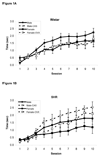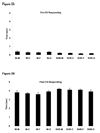Effects of sex hormones on associative learning in spontaneously hypertensive rats
- PMID: 18054054
- PMCID: PMC2323907
- DOI: 10.1016/j.physbeh.2007.11.005
Effects of sex hormones on associative learning in spontaneously hypertensive rats
Abstract
Pavlovian conditioning of a visual stimulus paired with food was examined in spontaneously hypertensive rats (SHR), which are a commonly used model for Attention-Deficit/Hyperactivity Disorder (ADHD), and in Wistar rats (normoactive control). In gonadally intact rats of both strains, males spent more time in the food cup following onset of the light than did females, indicating a stronger association of the conditioned stimulus (CS) with reward. Gonadectomy carried out in adulthood affected conditioning differently in the two strains. In Wistar rats, gonadectomy had no effect on conditioned responding in females, but reduced conditioned responding in males, effectively eliminating the sex difference in behavior. This result suggests that circulating androgens in male Wistar rats normally aid conditioning in this task. In contrast, gonadectomy enhanced conditioning in both sexes in the SHR rats, indicating that androgens and/or estrogens impair conditioned associations in this strain. These data indicate that gonadal steroids can influence conditioning in rats and that the valence of steroid action on this behavior is strain-dependent. To the extent that SHR serves as a model of ADHD in humans, the influence of steroids on associative learning may play a role in the expression of ADHD-like behaviors.
Figures



Similar articles
-
Sex differences in learning and inhibition in spontaneously hypertensive rats.Behav Brain Res. 2008 Feb 11;187(1):27-32. doi: 10.1016/j.bbr.2007.08.022. Epub 2007 Aug 25. Behav Brain Res. 2008. PMID: 17904233 Free PMC article.
-
Instrumental conditioning for food reinforcement in the spontaneously hypertensive rat model of attention deficit hyperactivity disorder.BMC Res Notes. 2017 Oct 30;10(1):525. doi: 10.1186/s13104-017-2857-5. BMC Res Notes. 2017. PMID: 29084583 Free PMC article.
-
Appetitive and consummative responding for liquid sucrose in the spontaneously hypertensive rat model of attention deficit hyperactivity disorder.Behav Brain Res. 2013 Feb 1;238:232-42. doi: 10.1016/j.bbr.2012.10.025. Epub 2012 Oct 29. Behav Brain Res. 2013. PMID: 23117093
-
The spontaneously hypertensive-rat as an animal model of ADHD: evidence for impulsive and non-impulsive subpopulations.Neurosci Biobehav Rev. 2003 Nov;27(7):639-51. doi: 10.1016/j.neubiorev.2003.08.007. Neurosci Biobehav Rev. 2003. PMID: 14624808 Review.
-
Rodent models of attention-deficit/hyperactivity disorder.Biol Psychiatry. 2005 Jun 1;57(11):1239-47. doi: 10.1016/j.biopsych.2005.02.002. Biol Psychiatry. 2005. PMID: 15949994 Review.
Cited by
-
Characterization of cognitive deficits in spontaneously hypertensive rats, accompanied by brain insulin receptor dysfunction.J Mol Psychiatry. 2015 Jun 4;3(1):6. doi: 10.1186/s40303-015-0012-6. eCollection 2015. J Mol Psychiatry. 2015. PMID: 26110057 Free PMC article.
-
Differential Behavioral and Biochemical Responses to Caffeine in Male and Female Rats from a Validated Model of Attention Deficit and Hyperactivity Disorder.Mol Neurobiol. 2018 Nov;55(11):8486-8498. doi: 10.1007/s12035-018-1000-5. Epub 2018 Mar 20. Mol Neurobiol. 2018. PMID: 29557061
-
Sex, ADHD symptoms, and smoking outcomes: an integrative model.Med Hypotheses. 2012 May;78(5):585-93. doi: 10.1016/j.mehy.2012.01.034. Epub 2012 Feb 15. Med Hypotheses. 2012. PMID: 22341778 Free PMC article. Review.
-
Maternal Hyperandrogenemia and the Long-Term Neuropsychological, Sex Developmental, and Metabolic Effects on Offspring.Int J Mol Sci. 2025 Feb 28;26(5):2199. doi: 10.3390/ijms26052199. Int J Mol Sci. 2025. PMID: 40076815 Free PMC article. Review.
-
Potential hormonal mechanisms of attention-deficit/hyperactivity disorder and major depressive disorder: a new perspective.Horm Behav. 2009 Apr;55(4):465-79. doi: 10.1016/j.yhbeh.2009.02.004. Epub 2009 Mar 2. Horm Behav. 2009. PMID: 19265696 Free PMC article. Review.
References
-
- American Psychiatric Association. U.S. Government Printing Office. 4th ed. U.S. Government Printing Office; 2000. Diagnostic and Statistical Manual of Mental Disorders.
-
- Gaub M, Carlson CL. Gender differences in ADHD: a meta-analysis and critical review. J. Am. Acad. Child Adolesc. Psychiatry. 1997;36:1036–1045. - PubMed
-
- Lahey BB, Miller TI, Gordon RA, Riley AW. Developmental epidemiology of the disruptive behavior disorders. In: H.C. Quay HC, Hogan AE, editors. Handbook of Disruptive Behavior Disorders. New York: Kluwer/Plenum; 1999. pp. 23–48.
-
- Wolraich ML, Hannah JN, Pinnock TY, Baumgaertel A, Brown J. Comparison of diagnostic criteria for attention-deficit hyperactivity disorder in a county-wide sample. J. Am. Acad. Child Adolesc. Psychiatry. 1996;35:319–324. - PubMed
-
- Feifel D. Attention-deficit hyperactivity disorder in adults. Postgrad. Med. 1991;100:207–218. - PubMed
Publication types
MeSH terms
Substances
Grants and funding
LinkOut - more resources
Full Text Sources

